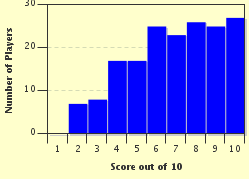Quiz Answer Key and Fun Facts
1. The largest country in South America is Brazil. What is the origin of the name 'Brazil'?
2. The word 'Paraguay' has several different interpretations but most agree on one theme. Which geographical feature is it?
3. What area of South America was named by Magellan, because he thought the people were giants?
4. The group of islands at the bottom tip of the continent are known as Tierra del Fuego. What is the best English translation for this name?
5. The Argentinians know them as Islas Malvinas, but the English call them the Falkland Islands. Where does the English name come from?
6. Which South American location is NOT named after a European explorer?
7. The Atlantic Ocean borders the eastern side of South America. Which language does the word 'Atlantic' come from?
8. La Paz is the capital of Bolivia, a landlocked country in the middle of the continent. La Paz is the abbreviated name for the city, but what does the full name mean in English?
9. Machu Picchu is a major Inca site in Peru, built around 1450. The name comes from the indigenous language, Quechua, but what does it mean?
10. Which large South American city was named after a city in Spain by Spanish explorer Jeronimo Luis de Cabrera, in 1573?
Source: Author
ozzz2002
This quiz was reviewed by FunTrivia editor
Tizzabelle before going online.
Any errors found in FunTrivia content are routinely corrected through our feedback system.


